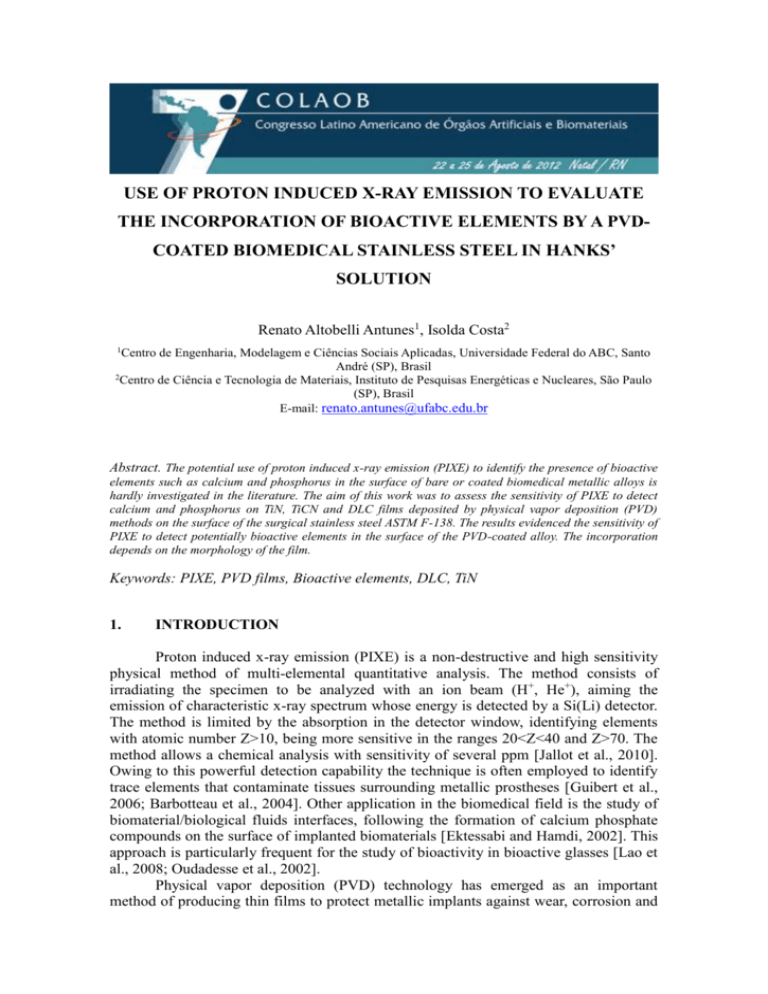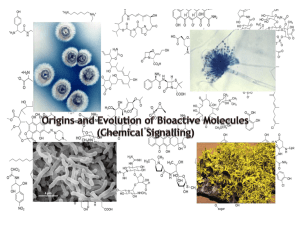Use of proton induced x-ray emission to evaluate the incorporation
advertisement

USE OF PROTON INDUCED X-RAY EMISSION TO EVALUATE THE INCORPORATION OF BIOACTIVE ELEMENTS BY A PVDCOATED BIOMEDICAL STAINLESS STEEL IN HANKS’ SOLUTION Renato Altobelli Antunes1, Isolda Costa2 1 Centro de Engenharia, Modelagem e Ciências Sociais Aplicadas, Universidade Federal do ABC, Santo André (SP), Brasil 2 Centro de Ciência e Tecnologia de Materiais, Instituto de Pesquisas Energéticas e Nucleares, São Paulo (SP), Brasil E-mail: renato.antunes@ufabc.edu.br Abstract. The potential use of proton induced x-ray emission (PIXE) to identify the presence of bioactive elements such as calcium and phosphorus in the surface of bare or coated biomedical metallic alloys is hardly investigated in the literature. The aim of this work was to assess the sensitivity of PIXE to detect calcium and phosphorus on TiN, TiCN and DLC films deposited by physical vapor deposition (PVD) methods on the surface of the surgical stainless steel ASTM F-138. The results evidenced the sensitivity of PIXE to detect potentially bioactive elements in the surface of the PVD-coated alloy. The incorporation depends on the morphology of the film. Keywords: PIXE, PVD films, Bioactive elements, DLC, TiN 1. INTRODUCTION Proton induced x-ray emission (PIXE) is a non-destructive and high sensitivity physical method of multi-elemental quantitative analysis. The method consists of irradiating the specimen to be analyzed with an ion beam (H+, He+), aiming the emission of characteristic x-ray spectrum whose energy is detected by a Si(Li) detector. The method is limited by the absorption in the detector window, identifying elements with atomic number Z>10, being more sensitive in the ranges 20<Z<40 and Z>70. The method allows a chemical analysis with sensitivity of several ppm [Jallot et al., 2010]. Owing to this powerful detection capability the technique is often employed to identify trace elements that contaminate tissues surrounding metallic prostheses [Guibert et al., 2006; Barbotteau et al., 2004]. Other application in the biomedical field is the study of biomaterial/biological fluids interfaces, following the formation of calcium phosphate compounds on the surface of implanted biomaterials [Ektessabi and Hamdi, 2002]. This approach is particularly frequent for the study of bioactivity in bioactive glasses [Lao et al., 2008; Oudadesse et al., 2002]. Physical vapor deposition (PVD) technology has emerged as an important method of producing thin films to protect metallic implants against wear, corrosion and fatigue during their service life [Antunes and De Oliveira, 2009]. Different ceramic hard coatings are employed with this purpose such as diamond like carbon (DLC), titanium nitride (TiN) and titanium carbonitride (TiCN) [Chu, 2006; Harman et al., 1997; Yang et al., 2007]. The overall performance of the films strongly depends on their morphology which is determined by the deposition method and parameters [Panjan et al., 2010]. The intrinsic biocompatibility of these films is well-established in the literature [Hasebe et al., 2007; Serro et al., 2009]. Conversely, few studies are devoted to the investigation of the bioactivity of PVD-coated metallic biomaterials. Piscanec et al. (2004) assessed the bioactivity of a TiN-coated titanium alloy. According to the results, the TiN layer was oxidized forming a TiOxNy phase. Ca2+ ions were, then, spontaneously adsorbed on the surface of this oxinitride, giving rise to the nucleation of a calcium phosphate compound. This study motivates similar investigations for other intrinsic biocompatible PVD layers such as TiCN and DLC. In this regard, the aim of this work was to use PIXE to evaluate the incorporation of bioactive elements, namely Ca and P by TiN, TiCN and DLC films deposited on the ASTM F-138 biomedical stainless steel after immersion in Hanks’ solution. 2. MATERIALS AND METHODS 2.1 Material The chemical composition of the ASTM F-138 stainless steel used in this work is shown in Table 1. Table 1. Chemical composition of the ASTM F-138 alloy used in this work. C Mass Si S P Cr Mn Cu Ni Mo N Fe 0,007 0,037 0,002 0,007 17,40 1,780 0,030 13,50 2,120 0,070 Bal. (%) 2.2 Deposition process TiN and TiCN coatings were deposited using a HTC 1200 PVD unit manufactured by Hauzer Techno Coating Europe BV Venlo, The Netherlands. This machine uses four orthogonally mounted cathodes (1000×170×14 mm), which surround a three fold rotation substrate holder turntable. The cathodes are equipped with a cathodic arc deposition technique. Before deposition, specimens were cleaned in phosphoric acid, alkaline and detergent solution and deionized water in an ultrasonic cleaner system. Metallic ion etching was also performed to improve adhesion. Ionized metallic ions were accelerated from cathode to tolls biased in 1200 V. The deposition occurs in four steps: pump down and heating, metal ion etching, reactive deposition and cool down. The detailed process parameters are show in Table 2. The deposition rate was 0.8–1.0 μm/h. The resulting film thickness was approximately 2 μm. DLC coating was deposited through a magnetron sputtering method. This film consists of a tungsten carbide containing DLC (W-DLC) with a thickness of approximately 2 m. The deposition system comprises a sputtering device with a tungsten carbide target (99.99% purity). The pressure of the process was kept constant at 0.8 Pa. The temperature of the substrate was held at 180 ºC during deposition. The concentration of acetylene during in the deposition chamber was 70 sccm and that of argon was 200 sccm. Table 2. Deposition parameters for the TiN and TiCN films. Parameter Pressure Substrate bias Arc current Substrate temperature Deposition time Cooling time Value 1 Pa 200 V 50 A 450 – 500 ºC 5400 s 7200 s 2.3 PIXE A detailed description of the PIXE measurement method is given elsewhere [Aburaya et al., 2006]. The analyses were conducted with the ASTM F-138 stainless steel coated by the TiN, TiCN and DLC layers deposited through the conditions described in the previous sub-section. The bare substrate was also tested for comparison purposes. The measurements were performed with specimens that were not immersed in physiological solution and with specimens immersed in Hanks’ solution at 37 ºC for 28 days. 2.4 Film morphology The morphology of the TiN, TiCN and DLC films was observed through scanning electron microscopy (microscope Philips XL30 SEM). 3. RESULTS AND DISCUSSION 3.1 SEM micrographs SEM micrographs of the PVD layers are shown in Fig. 1. As expected, the presence of microdefects was observed in the films. Pinholes and macroparticles are intrinsically produced during the PVD processes. Macroparticles are originated from molten particles generated during the evaporation of the metallic target during the PVD process which can solidify on the surface of the substrate. They can give rise to porosity, forming new pathways to the penetration of electrolyte, thus harming the corrosion resistance of the coated substrate. Chenglong et al. (2005) and Yang et al. (2005) have found similar characteristics for TiN layers produced by PVD processes. Liu et al. (1995) reported the formation of pinholes whose diameter reached at to 3 m in PVD thin films. As seen in Fig. 1, the presence of macroparticles is more accentuated on the DLC surface than on the TiN and TiCN films. If, in one hand, the intrinsic defects can be deleterious to the corrosion resistance of the base material, in the other hand, they can facilitate the incorporation of potentially bioactive elements from the solution. a) Pinholes Macroparticles Pinholes b) Pinholes Macroparticles c) Figure 1. SEM micrographs of the PVD films: a) TiN; b) TiCN; c) DLC. 3.2 PIXE measurements Table 3 shows PIXE results for the concentration of elements on the surface of the ASTM F-138 substrate non-immersed and immersed in Hanks’ solution at 37 ºC for 28 days. Only the main alloying elements of the steel (Fe, Cr, Ni and Mo) and the potentially bioactive elements (Ca and P) are displayed in the table. Table 3. PIXE results for the concentration of elements on the surface of the ASTM F-138 substrate non-immersed and immersed in Hanks’ solution at 37 ºC for 28 days. Concentration (mass %) Element Non-immersed Immersed P ----- 0.09 Ca 0.02 0.04 Fe 60.7 60.5 Cr 21.0 20.9 Ni 13.2 13.2 Mo 1.86 1.95 As shown in Table 3 phosphorus was identified only after immersion in Hanks’ solution for the bare ASTM F-138 specimen where calcium appeared as an impurity even in the non-immersed condition. The high sensitivity of the PIXE analysis is evident, as very few amounts of the potentially bioactive elements could be unequivocally identified. Bioactivity of stainless steel implants has never been reported. Indeed, this result should not be envisaged as an indication of bioactivity for the bare ASTM F-138 but rather as an evidence of the suitability of the PIXE method to analyze trace elements on the surface of biomaterials. It is interesting to note that the concentration of the most abundant elements in the alloy remained relatively unchanged after immersion, suggesting that the material was stable in the testing conditions. Tables 4 to 6 show PIXE results for the concentration of elements on the surface of the TiN-coated, TiCN-coated and DLC-coated ASTM F-138 stainless steel nonimmersed and immersed in Hanks’ solution at 37 ºC for 28 days. Only the main alloying elements of the steel (Fe, Cr, Ni and Mo), the potentially bioactive elements (Ca and P) and the main constituent of each film (Ti for the TiN and TiCN films and W for the DLC film) are displayed in the table. Nitrogen and carbon are not displayed due to the limitation of PIXE to detect elements with Z<15. The TiN-coated and TiCN-coated specimens did not present evidence of incorporation of the bioactive elements P and Ca. These elements have been found in both PVD layers even before immersion in Hanks’ solution. After immersion, the relative mass of both Ca and P was not significantly altered and any variation can be ascribed to inherent measurement errors associated with the PIXE technique. For the DLC-coated steel the amount of Ca and P increased more significantly after immersion in Hanks’ solution. This result does not confirm the formation of bioactive compounds, as the PIXE method as only used to identify each element separately. However, it is an indication that the DLC film is apparently more prone to incorporate the bioactive elements than the TiN and TiCN layers. Table 4. PIXE results for the concentration of elements on the surface of the TiN film non-immersed and immersed in Hanks’ solution at 37 ºC for 28 days. Concentration (mass %) Element Non-immersed Immersed P 0.03 0.05 Ca 0.02 0.01 Fe 55.8 55.0 Cr 18.0 17.6 Ni 12.8 12.5 Mo 1.68 1.66 Ti 8.89 10.3 Table 5. PIXE results for the concentration of elements on the surface of the TiCN film non-immersed and immersed in Hanks’ solution at 37 ºC for 28 days. Concentration (mass %) Element Non-immersed Immersed P 0.04 0.04 Ca 0.01 0.01 Fe 58.1 58.3 Cr 19.4 19.5 Ni 13.0 12.9 Mo 1.77 1.76 Ti 4.54 4.35 Table 6. PIXE results for the concentration of elements on the surface of the DLC film non-immersed and immersed in Hanks’ solution at 37 ºC for 28 days. Concentration (mass %) Element Non-immersed Immersed P 0.03 0.07 Ca 0.01 0.08 Fe 54.1 52.7 Cr 18.2 17.8 Ni 10.4 11.5 Mo 1.42 1.39 W 5.59 5.81 Indeed, there are some reports in the literature investigating the osteoinductive properties of DLC films [Olivares et al., 2007; Cui et al.; 2005). It is generally agreed that some degree of porosity favors the osseointegration of implants. In this regard, coated prostheses should encompass this characteristic in order to facilitate the incorporation of bioactive elements. This seems to be the case of the DLC films evaluated in this work. As observed in the SEM micrographs of Fig. 1, DLC film was more defective than the TiN and TiCN layers, favoring the development of porosity during immersion in Hanks’ solution. PIXE analysis evidenced the incorporation of Ca and P from the solution in the DLC film, but not in the TiN and TiCN layers. 4. CONCLUSIONS SEM micrographs revealed the presence of pinholes and macroparticles on the surface of the TiN, TiCN and DLC films. The DLC layer was more defective than the TiN and TiCN films. PIXE analysis proved to be very sensitive, successfully identifying the bioactive trace elements Ca and P. Moreover, the technique evidenced that the DLC film incorporated Ca and P from the Hanks’ solution. Conversely, this incorporation was not confirmed for the TiN and TiCN layers. The more defective nature of the DLC film seems to be important to favor the incorporation of the bioactive elements. PIXE is a suitable method to detect this phenomenon in biomedical metallic alloys. ACKNOWLEDGEMENTS The authors are grateful to CNPq for the financial support to this work. Bodycote Brasimet, especially Dr. Ronaldo Ruas, is acknowledged for kindly performing the deposition of the PVD layers employed in this work. Especial thanks are given to Dr. Márcia de Almeida Rizzutto from the Institute of Physics (University of São Paulo) for her invaluable help with the PIXE measurements and discussion of the corresponding results. REFERENCES 1. Aburaya J.H., Added N., Tabacniks M.H., Rizzutto M.A., Barbosa M.D.L., Nucl. Int. and Meth. B 249 (2006) 792. 2. Antunes R.A.,. De Oliveira M.C.L, Crit. Rev. Biomed. Eng. 37 (2009) 425. 3. Barbotteau Y., Irigaray J.L., Moretto Ph., Nucl. Inst. And Meth. B 215 (2004) 214. 4. Chenglong L., Dazhi Y., Guoqiang L., Min Q., Mater. Let. 59 (2005) 3813. 5. Chu, P.K., Nucl. Inst. and Meth. B 242 (2006) 1. 6. Cui F.Z., Qing X.L., Lib D.J., Zhao J., Surf. Coat. Technol. 200 (2005) 1009. 7. Ektessabi A.M., Hamdi M., Surf. Coat. Technol. 153 (2002) 10. 8. Guibert G., Irigaray J.L., Moretto Ph., Sauvage T., Kemeny J.L., Cazenave A., Jallot E., Nucl. Inst. And Meth. B 251 (2006) 246. 9. Harman M.K., Banks S.A., Hodge W.A., J. Arthroplasty 8 (1997) 938. 10.Hasebe T., Ishimaru T., Kamijo A., Yoshimoto Y., Yoshimura T., Yohena T., Kodama H., Hotta A., 11.Takahashi K., Suzuki T., Diamond Relat. Mater. 16 (2007) 1343. 12. Jallot E., Raissle O., Soulie J., Lao J., Guibert G., Nedelec J.-M., Adv. Biomater. 12 (2010) B245. 13. Lao J., Nedelec J.M., Moretto Ph., Jallot E., Nucl. Inst. And Meth. B 266 (2008) 2412. 14. Liu C., Leyland A., Lyon S., Matthews A., Surf. Coat. Technol. 76-77 (1995) 615. 15. Olivares R., Rodil S.E., Arzate H., Diamond Relat Mater. 16 (2007) 1858. 16. Oudadesse H., Irigaray J.L., Barbotteau Y., Brun V., Moretto Ph., Nucl. Inst. and Meth. B 190 (2002) 458. 17. Panjan P., Cekada M., Panjan M., Kek-Merl D., Vacuum 84 (2010) 209. 18. Piscanec S., Ciacchi L.C., Vesselli E., Comelli G., Sbaizero O., Meriani S., De Vita A., Acta Mater. 57 (2004) 1237. 19. Serro A.P., Completo C., Colaço R., Dos Santos F., Silva C.L., Cabral J.M.S., Araújo H., Pires E., 20. Saramago B., Surf. Coat. Technol. 203 (2009) 3701. 21. Yang D., Liu C., Liu X., Qi M. Lin G., Current Appl. Phys. 5 (2005) 417. 22. Yang Y.L., Zhang D, Kou H.S., Acta Metall. Sin. (Engl. Lett.) 20 (2007) 210.





